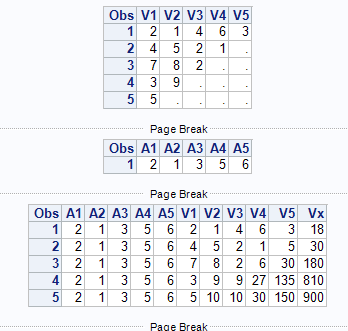- Home
- /
- Programming
- /
- SAS Procedures
- /
- Successively multiply values of lower part of a matrix with an array
- RSS Feed
- Mark Topic as New
- Mark Topic as Read
- Float this Topic for Current User
- Bookmark
- Subscribe
- Mute
- Printer Friendly Page
- Mark as New
- Bookmark
- Subscribe
- Mute
- RSS Feed
- Permalink
- Report Inappropriate Content
Hi all,
I would appreciate your help on the following.
I have two data sets (arrays)
Data X
| V1 | V2 | V3 | V4 | V5 |
| 2 | 1 | 4 | 6 | 3 |
| 4 | 5 | 2 | 1 | |
| 7 | 8 | 2 | ||
| 3 | 9 | |||
| 5 |
and Data Y
| A1 | A2 | A3 | A4 | A5 |
| 2 | 1 | 3 | 5 | 6 |
I would like to fill the missing lower part of the matrix by successively multiplying the previous non-missing value of Data X with the elements of the Data Y
i.e. for the last observation 10= 5*2 (A1), 10= 10 * 1 (A2), 30=10* 3 (A3) , 150 = 30 * 5 (A4) and 900 = 150 * 6(A5)
Consequently column V_New will be created due to final multiplication.
So Data Z is the desired one
| V1 | V2 | V3 | V4 | V5 | V_New |
| 2 | 1 | 4 | 6 | 3 | 18 |
| 4 | 5 | 2 | 1 | 5 | 30 |
| 7 | 8 | 2 | 6 | 30 | 180 |
| 3 | 9 | 9 | 27 | 135 | 810 |
| 5 | 10 | 10 | 30 | 150 | 900 |
Thank you in advance.
Nik
Accepted Solutions
- Mark as New
- Bookmark
- Subscribe
- Mute
- RSS Feed
- Permalink
- Report Inappropriate Content
infile cards expandtabs missover;
input V1-V5;
cards;
2 1 4 6 3
4 5 2 1
7 8 2
3 9
5
;;;;
run;
proc print;
run;
Data a;
infile cards expandtabs;
input A1-A5;
cards;
2 1 3 5 6
;;;;
run;
proc print;
run;
data mult;
if _n_ eq 1 then set a;
set v;
array v
v[j+1] = a
end;
drop i j;
run;
proc print;
run;

- Mark as New
- Bookmark
- Subscribe
- Mute
- RSS Feed
- Permalink
- Report Inappropriate Content
infile cards expandtabs missover;
input V1-V5;
cards;
2 1 4 6 3
4 5 2 1
7 8 2
3 9
5
;;;;
run;
proc print;
run;
Data a;
infile cards expandtabs;
input A1-A5;
cards;
2 1 3 5 6
;;;;
run;
proc print;
run;
data mult;
if _n_ eq 1 then set a;
set v;
array v
v[j+1] = a
end;
drop i j;
run;
proc print;
run;

- Mark as New
- Bookmark
- Subscribe
- Mute
- RSS Feed
- Permalink
- Report Inappropriate Content
I like such kind of questions.
data v;
infile cards expandtabs missover;
input V1-V5;
cards;
2 1 4 6 3
4 5 2 1
7 8 2
3 9
5
;;;;
run;
Data a;
infile cards expandtabs;
input A1-A5;
cards;
2 1 3 5 6
;;;;
run;
data want;
if _n_ eq 1 then set a;
set v;
array x{*} v1-v5 v_new;
array y{*} a1-a5;
do i=1 to dim(x)-1;
temp=x{i}*y{i};
if missing(x{i+1}) then x{i+1}=temp;
end;
drop temp i a:;
run;
Xia Keshan
Don't miss out on SAS Innovate - Register now for the FREE Livestream!
Can't make it to Vegas? No problem! Watch our general sessions LIVE or on-demand starting April 17th. Hear from SAS execs, best-selling author Adam Grant, Hot Ones host Sean Evans, top tech journalist Kara Swisher, AI expert Cassie Kozyrkov, and the mind-blowing dance crew iLuminate! Plus, get access to over 20 breakout sessions.
Learn the difference between classical and Bayesian statistical approaches and see a few PROC examples to perform Bayesian analysis in this video.
Find more tutorials on the SAS Users YouTube channel.
 Click image to register for webinar
Click image to register for webinar
Classroom Training Available!
Select SAS Training centers are offering in-person courses. View upcoming courses for:




